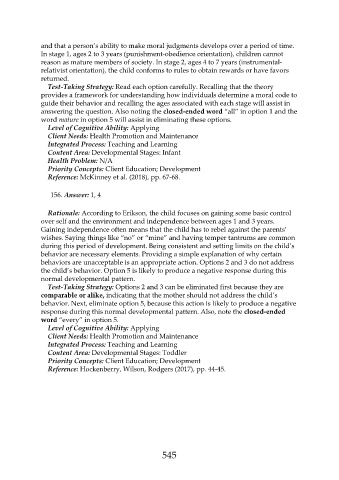Page 545 - Saunders Comprehensive Review For NCLEX-RN
P. 545
and that a person’s ability to make moral judgments develops over a period of time.
In stage 1, ages 2 to 3 years (punishment-obedience orientation), children cannot
reason as mature members of society. In stage 2, ages 4 to 7 years (instrumental-
relativist orientation), the child conforms to rules to obtain rewards or have favors
returned.
Test-Taking Strategy: Read each option carefully. Recalling that the theory
provides a framework for understanding how individuals determine a moral code to
guide their behavior and recalling the ages associated with each stage will assist in
answering the question. Also noting the closed-ended word “all” in option 1 and the
word mature in option 5 will assist in eliminating these options.
Level of Cognitive Ability: Applying
Client Needs: Health Promotion and Maintenance
Integrated Process: Teaching and Learning
Content Area: Developmental Stages: Infant
Health Problem: N/A
Priority Concepts: Client Education; Development
Reference: McKinney et al. (2018), pp. 67-68.
156. Answer: 1, 4
Rationale: According to Erikson, the child focuses on gaining some basic control
over self and the environment and independence between ages 1 and 3 years.
Gaining independence often means that the child has to rebel against the parents’
wishes. Saying things like “no” or “mine” and having temper tantrums are common
during this period of development. Being consistent and setting limits on the child’s
behavior are necessary elements. Providing a simple explanation of why certain
behaviors are unacceptable is an appropriate action. Options 2 and 3 do not address
the child’s behavior. Option 5 is likely to produce a negative response during this
normal developmental pattern.
Test-Taking Strategy: Options 2 and 3 can be eliminated first because they are
comparable or alike, indicating that the mother should not address the child’s
behavior. Next, eliminate option 5, because this action is likely to produce a negative
response during this normal developmental pattern. Also, note the closed-ended
word “every” in option 5.
Level of Cognitive Ability: Applying
Client Needs: Health Promotion and Maintenance
Integrated Process: Teaching and Learning
Content Area: Developmental Stages: Toddler
Priority Concepts: Client Education; Development
Reference: Hockenberry, Wilson, Rodgers (2017), pp. 44-45.
545

